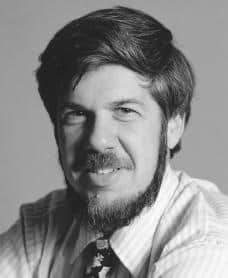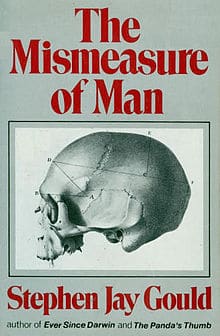Stephen Jay Gould: Scientist in the Service of Ideology
Richard Lynn, American Renaissance, July 2002

Stephen Jay Gould
With the death of Stephen Jay Gould on May 20, 2002, the world has lost one of its most determined — and mendacious — advocates of the view there is no relationship between race, intelligence and brain size. Not surprisingly, he has been widely acclaimed in obituaries for his contributions to evolutionary biology and for his critiques of the concept of intelligence, its heritability, and race differences. The New York Times called him “one of the most influential evolutionary biologists of the twentieth century;” the Washington Post said he was “a brilliant scientist;” the Los Angeles Times pronounced him “a latter-day Darwin,” and the London Times called him “one of the most gifted evolutionary scientists of his generation.”
All this, however, is in striking contrast to the evaluation of his work by fellow-scientists, most of whom regarded him as a lightweight and even a charlatan. Professor Maynard Smith, a leading evolutionary biologist, has written that others in the field “tend to see him as a man whose ideas are so confused as hardly to be worth bothering with.” Speaking for psychologists, Chris Brand has written that Gould’s Mismeasure of Man is “a masterpiece of deception;” and Professor Philippe Rushton has written of Gould’s “career of relentless special pleading.” Even anthropologists Milford Wolpoff and Rachel Caspari, who uncritically accept many of Gould’s distortions, have written that his writings “invariably have a not-so-hidden political agenda.” Professor Steve Jones, an evolutionary biologist who largely agrees with Gould on intelligence and race, has said that “scientifically, he was a failure.”
Gould posed as a scientist concerned only with truth. He even wrote, “May I end up next to Judas Iscariot, Brutus and Cassius in the devil’s mouth at the center of hell if I ever fail to present my most honest assessment and best judgment of evidence for empirical truth.” Even to make such a claim suggests he had something to hide. His work was strongly politically motivated, and it is difficult not to conclude that he advanced his political views at the expense of scientific integrity.
And what were his views? “He learned Marxism on his father’s knee,” according to a sympathetic article in the magazine Skeptic, which he helped found. “Gould’s politics were solidly left of center” wrote Joel Achenbach in his obituary in the Los Angeles Times. It would be more correct to say that he was on the extreme left, and his writing consistently supported his politics.
In his work in evolutionary biology, Gould’s strategy was to latch onto an idea, give it a clever-sounding name, and promote it through his popular writings in magazines and books as an important new concept. His principal theory was what he called “punctuated equilibrium.” He asserted that evolutionary biologists from Darwin onwards supposed that evolution took place gradually and steadily. He announced this was all wrong, and that evolution takes place in fits and starts. For a long period, there are no changes, and then in a short space of time species evolve rapidly.

In so far as this occurs, it had been recognized long before Gould promoted it. Typically species evolve slowly over many millions of years but during some periods they evolve more rapidly. For example, the brain size of mammals has increased gradually and steadily over the last 60 million years or so, during which time it roughly doubled, but during the last 5 million years the brain size of the hominids, the evolutionary line from apes to humans, evolved much more rapidly and approximately tripled in size.
Still, Gould succeeded in convincing journalists he had had a brilliant new insight. For The New York Times it was “a revolutionary suggestion.” Among biologists it was generally understood that all Gould had done was to dress up with a fancy name something that had long been known . As the New York Times obituary discreetly put it, “Outside of academia, Gould was almost universally adored.” Implied but not stated was that inside academia, he was not held in much regard.
Gould on Intelligence
Gould’s reputation was even lower among psychologists than biologists. His writings on intelligence, particularly his The Mismeasure of Man, appeared systematically to misrepresent the truth. Gould frequently wrote that psychologists “reify” intelligence, and regard it as a “thing.” In fact, psychologists regard intelligence as a construct — something like gravity — a concept that explains a number of observable phenomena. This is an example of Gould’s strategy of setting up straw men and demolishing them.
The Mismeasure of Man was published in 1981, and a slightly revised second edition was republished in 1996. It is instructive to compare them. In the first edition Gould dismissed the idea that intelligence is positively related to brain size, although this had been established by the consistent results of some fifteen studies. The first to make this claim was Samuel Morton (1799–1851), who filled skulls with small seeds to compare their volume. Gould claimed to have remeasured Morton’s skulls, and found that Morton had doctored the results to prove whites have larger skulls than blacks. This is how Gould patronizingly describes Morton’s work:
Morton, measuring by seed, picks up a threateningly large black skull, fills it lightly and gives it a few desultory shakes. Next, he takes a distressingly small Caucasian skull, shakes hard, and pushes mightily at the foramen magnum with his thumb. It is easily done, without conscious motivation; expectation is a powerful guide to action (p.97).
Astonishingly, when Gould remeasured Morton’s skulls he confirmed that Morton was right! Gould’s “corrected” measures were brain sizes of 87 cubic inches for whites and 83 cubic inches for blacks. From this he concluded that “my correction of Morton’s conventional ranking reveals no significant differences among the races” — an incredible conclusion for a larger white brain size of approximately five percent.
During the 15 years between the first and second editions, there was a considerable amount of published work on the relationship between brain size and intelligence. In 1984 Professor Kenneth Beals reported world data for approximately 20,000 crania, and found white-black differences similar to those found by Morton. Professor Philippe Rushton has reported several data sets that confirm these results, and has recorded that he sent his papers describing these results to Gould. Gould did not reply, but must have concluded that the evidence was so strong he could no longer dispute it. Instead of writing a correction, he simply removed all references to brain size from the second edition.
Another issue on which Gould misrepresented the facts was the purported role of intelligence tests in excluding Jewish refugees from Germany in the 1930s. He asserted that IQ-tester and eugenicist Henry Goddard had identified immigrants from Eastern and Southern Europe as having low average intelligence, and had claimed four-fifths of Jewish immigrants were feeble minded. Gould asserted further that this influenced the passage of the 1924 Immigration Act, which limited the numbers of immigrants admitted from Eastern and Southern Europe, with the result that many Jews could not come and perished in the Holocaust. By this chain of reasoning he was able to blame the Holocaust on the false conclusions of intelligence testers.
The first two steps in this chain of reasoning are certainly wrong. Goddard never claimed four-fifths of Jews were feeble minded. Moreover, there is no evidence Congress was influenced by his or anyone else’s work on intelligence in passing the 1924 Immigration Act. Immigration had been running at around one million a year, and Congress was worried about integrating so many foreigners. Finally, even if these assertions were correct, there were other countries to which Jews could have gone to escape persecution in Nazi Germany.
Carl Degler in his 1991 book In Search of Human Nature corrected a number of Gould’s mistakes about Goddard, but true to form, Gould repeated the same mistakes in the second edition of The Mismeasure of Man. According to Rita Colwell, director of the National Science Foundation, Gould “didn’t tolerate shoddy science.” In fact, when it suited him, he practiced it.
Professor John Carroll, an expert on the statistical method of factor analysis, is a leading psychologist critical of Gould. In a 1995 article in the journal Intelligence, Prof. Carroll begins by noting that The Mismeasure of Man has been “much discussed among intellectual dilettantes,” but is full of errors. He writes that Gould’s “account of the history of mental testing may be regarded as badly biased and crafted in such a way as to prejudice the general public and even some scientists against almost any research concentrating on human abilities.” He also writes of Gould’s “gross misrepresentation of Thurstone’s views and methods of thinking” on factor analysis and the nature of intelligence, and of his “many errors in interpreting factor analysis.”
Hans Eysenck (1916–1997), a psychologist who worked in London and wrote more than 70 books, summarized Gould’s work on intelligence in his posthumously published 1998 book, Intelligence — A New Look:
S. J. Gould’s Mismeasure of Man is a paleontologist’s distorted view of what psychologists think, untutored in even the most elementary facts of the science. Gould is one of a number of politically motivated scientists who have consistently misled the public about what psychologists are doing in the field of intelligence, what they have discovered and what conclusions they have come to. Gould simply refuses to mention unquestionable facts that do not fit into his politically correct version; he shamelessly attacks the reputations of eminent scientists of whom he disapproves, on completely nonfactual grounds, and he misrepresents the views of scientists.
It is not difficult to understand why journalists writing for The New York Times and The New York Review of Books were so effusive about Gould, while scientists were so critical. Journalists have the same liberal-left beliefs as Gould. When they read him, they read what they wanted to hear, and they did not have the knowledge or integrity to question what he wrote. As for Gould himself, he must have known he was deliberately misrepresenting the evidence to suit his political agenda — and it was he who said scientists who do this deserve to spend the afterlife in the bottom circle of the Inferno.















